|
|
|
VU-1
![]()
VU-1’s history began
on 20 July 1951; when Utility Squadron One was established at Naval Air Station
Barbers Point, Hawaii in response to demands of the Korean War. VU-1 provided
training and support for fleet units in the 14th Naval District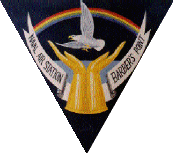 47, disestablished
30 April 1949.
With the end of WW II, Barbers Point served as
a demobilization center for more than 6,000 personnel leaving for civilian life.
During the late 1940s, the station was the beneficiary of a consolidation of
naval aviation facilities on the leeward side of the island. Barbers Point
absorbed MCAS Ewa in 1952 as Marine Corps units were shifted to Kaneohe Bay,
which had been closed as an NAS in 1949. NAS Honolulu was reduced to an OLF for
seaplanes and operations at Ford Island were reduced. The Coast Guard aircraft
at Kaneohe Bay were moved to Barbers Point.
47, disestablished
30 April 1949.
With the end of WW II, Barbers Point served as
a demobilization center for more than 6,000 personnel leaving for civilian life.
During the late 1940s, the station was the beneficiary of a consolidation of
naval aviation facilities on the leeward side of the island. Barbers Point
absorbed MCAS Ewa in 1952 as Marine Corps units were shifted to Kaneohe Bay,
which had been closed as an NAS in 1949. NAS Honolulu was reduced to an OLF for
seaplanes and operations at Ford Island were reduced. The Coast Guard aircraft
at Kaneohe Bay were moved to Barbers Point.
The outbreak of hot war in Korea in 1950 and the
chills of the cold war increased activity at Barbers Point. Patrol Squadron (VP)
6, which brought the firs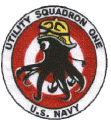 t P2V Neptune patrol planes to Hawaii, deployed to Japan
and engaged in combat. The mid-1950s brought WV-2 (later EC-121K) Warning Stars to
Barbers Point. These aircraft were operated by Airborne Early Warning Squadrons
12 and 14, which were merged in 1960 to form Airborne Early
Warning Barrier Squadron, Pacific. These aircraft maintained a continuous
distant early warning barrier patrol over the Pacific until June 1965.
t P2V Neptune patrol planes to Hawaii, deployed to Japan
and engaged in combat. The mid-1950s brought WV-2 (later EC-121K) Warning Stars to
Barbers Point. These aircraft were operated by Airborne Early Warning Squadrons
12 and 14, which were merged in 1960 to form Airborne Early
Warning Barrier Squadron, Pacific. These aircraft maintained a continuous
distant early warning barrier patrol over the Pacific until June 1965.
Construction of
an airfield west of Ewa began in November 1941, but was temporarily suspended
after the Japanese attack on Pearl Harbor so that construction crews could
rapidly complete Ewa. Barbers Point--originally intended as an OLF for NAS Ford
Island in Pearl Harbor--was still not complete when it was established as a
naval air station on 15 April 1942 with 14 officers and 242 enlisted personnel.
The new air station quickly became a hub of aviation activity as the Navy amassed forces in Hawaii to carry the war across the Pacific. Base operations centered on working up carrier air groups and squadrons for deployment to combat operations farther west. Carrier Air Service Unit 2 was assigned to the station to support the hosted squadrons.
Barbers
Point's level of activity grew steadily during the war. By the end of WW II, the
NAS was home to almost 13,000 personnel. The station hosted a combat aircrew
training unit which instructed pilots in aerial gunnery and a repair department
that overhauled thousands of aircraft engines.
The Navy’s most recent VU-1 began in 1951, when
Utility Squadron One VU-1) was established at NAS Barbers Point, Hawaii. From
its beginning, the second
VU-1 assumed the traditions of its Pacific Fleet Utility unit predecessor.
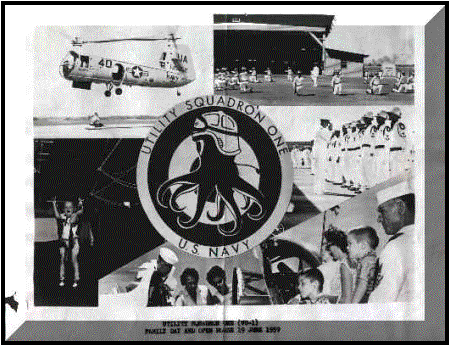

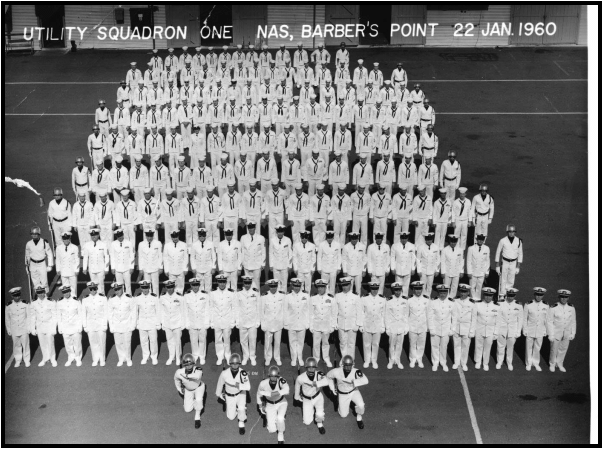
|
|
|
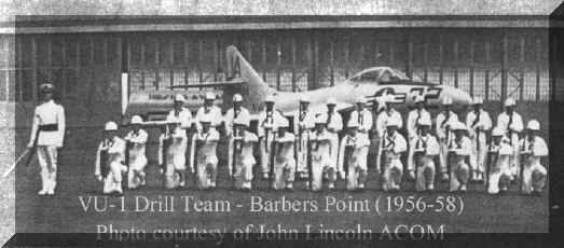
The "Skyraider" series was manufactured by
Douglas Aircraft beginning in World War II, and continued to distinguished
itself in service later in the Korean War. Thus, the Skyraider was kept in
production longer and underwent further design enhancements. The most
substantial redesign was the AD-5 series, which incorporated many lessons
learned in five years of operations with earlier versions of the aircraft (AD-1.
AD-2. AD-3. AD-4).
The AD5’s were two-seaters with a wide cockpit
which sat two side-by-side. The forward fuselage was also lengthened by two feet
with a Correspon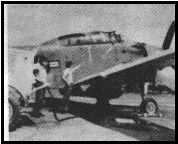 ding
increase in the vertical fin. A number of equipment changes were made, but the
armament of four
20 mm cannon was retained. This aircraft could carry its weight in
bombs. The AD5 series came with a conversion kit which permitted the basic
production versions to be quickly modified to serve in a variety of missions:
electronic warfare, night attack, airborne early-warning, ambulance,
freighter, target-tug and transport (with up to twelve seats).
ding
increase in the vertical fin. A number of equipment changes were made, but the
armament of four
20 mm cannon was retained. This aircraft could carry its weight in
bombs. The AD5 series came with a conversion kit which permitted the basic
production versions to be quickly modified to serve in a variety of missions:
electronic warfare, night attack, airborne early-warning, ambulance,
freighter, target-tug and transport (with up to twelve seats).
![]()
Radioplane KD2R5 "Shelduck"
Basic Training Target Drone

The Northrop KD2R5 "Shelduck" basic training
drone was used by the armed forces of at least countries. The KD2R5 was used as
a training device for ground-to-air gunnery practice. It was also used as a
training target for surface-to-air missiles such as the Seacat, Tigercat,
Redeye, Blowpipe, Sparrow, Chaparral, Hawk, Sidewinder and Nike.
| KD-21 was a Target Drone
Detachment of VU-1 and was comprised of about 10 enlisted guys and
an Officer-In-Charge. They regularly deployed aboard a ship out of
Pearl, usually a Fram destroyer, or a Carrier. They are the destroyers
that had been converted to carry drone Hilos, but the program went belly
up. They kept them because they had a hanger deck and a small flight
deck aft. The KD2R5 prop driven drone with a JATO assist and would be
flown out remotely about 8000 yards and turn inbound on one ship or
other in the task group. They'd be shooting at it with 3 or 5 inch guns
with proximity fuses in the rounds. A near miss sometimes knocked the
drone out of the sky, but it had a parachute that popped on that case.
Then the ship would be maneuvered alongside to retrieve it.
A typical cruise was 9 or 10 days out of Yokusuka,. with time for a
liberty or two in Tokyo as well.
Contributed by Ldcr. Robert (Mac) Palmer |
![]()
Grumman F9F Panther
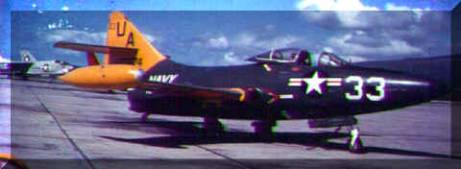
The Navy accepted 1,388 Panthers, which were 715 of the 826 Navy and Marine Corps jets deployed to Korea, and flew about 78,000 combat sorties. On November 9, 1950, an F9F-2 became the first Navy jet to down an enemy jet, the swept-wing MiG-15, which used the same Rolls-Royce engine design.
When war came to Korea on June 25, 1950, VF-51 and VF-52 loaded their
F9F-2 Panthers aboard the USS Valley Forge (CV-45) and put to sea.
Panthers from VF-51 were first in action on July 3, 1950, providing escort for a
strike against an airfield at Pyongyang. Ens E. W. Brown and Lt(jg) L. H. Plog
shared credit for downing a Yak-9, scoring the first kill credited to a Navy jet
fighter. Many of the surplus
Panthers were used as drones or as drone directors under the designation F9F-5K
or F9F-5KD. In 1962, the Defense Department eliminated separate designations for
Navy aircraft, and ordered that all Navy planes be redesignated under the new
Tri-Service unified designation scheme. The Panther/Cougar was assigned the
designation F-9 under the new system.
By this time, the only Panthers left in service were the
F9F-5KD drone
directors. These were redesignated DF-9E.
The last of these DF-9Es was stuck off charge in the mid-1960s. 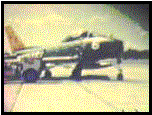 F9F's
went on the deliver more ordnance against enemy ground targets than any other
jet aircraft flown during the Korean Conflict. 87% of the US Navy and Marine
Corps jet aircraft flown in Korea were "Panthers". The 715 F9F's flown
in Korea flew a total of 78,000 sorties, averaging about 110 missions apiece.
One F9F set a record for the greatest tonnage of delivered ordnance by a single
aircraft in the war. This particular aircraft delivered over 400,000 lb. of
bombs, fired over 100,000 rounds, and wore out no less than 16 guns in combat.
F9F's
went on the deliver more ordnance against enemy ground targets than any other
jet aircraft flown during the Korean Conflict. 87% of the US Navy and Marine
Corps jet aircraft flown in Korea were "Panthers". The 715 F9F's flown
in Korea flew a total of 78,000 sorties, averaging about 110 missions apiece.
One F9F set a record for the greatest tonnage of delivered ordnance by a single
aircraft in the war. This particular aircraft delivered over 400,000 lb. of
bombs, fired over 100,000 rounds, and wore out no less than 16 guns in combat.
|
UTILITY
SQUADRON ONE
FOR NEARLY a quarter of a century—
October 5, 1925 to 16 May 1949 Utility Squadron One as handyman extraordinary served the Pacific
Fleet, doing what had to be done with outstanding efficiency. Its
tasks, varied and often difficult, never stumped VJ-1 and the Navy does
not mourn its passing, is only because, like the Phoenix, the squadron
rises from the ashes of decommissioning to fly again under the sign of
VU-7 to which many of its officers and men were transferred.
To go back to the
date of VJ-1's commissioning, one must travel through me, through the
first years of the atomic era, the long grueling months of World War
II, the 1930’s in which reparation was too often curtailed by (budget
limitations), the late 1920's of boom and bust. Finally one comes to a
bright October day at NAS San Diego, in 1925 when the squadron received
its name and mission.
The very word “utility,” which suggests a type of duty far
from glamorous, as a special luster when a squadron gives year after
year steady, effective service in many different ways. It may not be fun
to be useful, it may not be dramatic but it is essential. VJ-1 exhibited
a devotion to duty never once broken and, as the “aerial handymen of
the fleet,” its members diligently cared out their assignments.
It was not by chance
that the ships of the United States Pacific Fleet outshot and outfought
the best that the enemy could muster in World War II. It was VJ-1 and
squadrons like it that had provided
the antiaircraft gunnery practice so essential to the fleet. And
it hadn’t been easy, for in procuring the materials to set up
practice, the utility squadrons had to compete with combat units. But
persistence paid off, and the utility squadrons won their battle of
procurement sufficiently to train the fleet for AA duty in the Battle
of the Pacific.
But
in addition to towing targets, the other tasksVJ-1 was called upon to do
make a formidable list: torpedo photo and recovery, fighter director
practice, calibration of radar and radio instruments, submarine
coverage for protection during maneuvers and tests, spotting results
of large caliber and torpedo “live” firing practice, radar practice,
transportation of personnel and mail, air patrol and convoy coverage,
search and rescue, and photography. Were it not to suggest a general in
competency to do anything well, an implication utterly contrary to the
facts, the “J’, in the squadron designation might well stand for “jack-of-all-trades.” Right
from the first, VJ-1 was called upon to do aerial photography and
maintained its own laboratory. The squadron’s competency in this type
of work was recognized when a detachment was ordered in 1926 to Dutch
Harbor, Alaska, to do aerial mapping of an area hitherto uncharted. The
measure of the squadron’s success in this type of work is indicated by
the fact that in 1934, VJ-1 participated in the Second Alaskan Aerial
Survey Expedition which was sent to Kanaga Bay in the Aleutians. In
1938, Cdr. Allen I. Price wrote of the struggle of utility squadrons to
establish their right to exist as a growing naval unit: “Any attempt at a resume
of Utility Squadron’s history reads like the case history of an
extremely undesirable alien who,’ despite contempt and studied
shunning, keps coming back like a bad penny; and it is constantly popping up until in
desperation some one has to do something about it. That something was
the organization of the Utility Wing in 1934.”
FROM 1935 On, VJ-1 supplied tow-target services to two
antiaircraft’ gunnery
schools, one aboard the USS Utah at Long
Beach and the other on San Clemente Island, California. Early in 1937,
the squadron developed something the fleet very much needed, a type of
practice which enabled VJ-1 to simulate a dive-bombing attack. In April
of the same year, the Sikorsky S-34
plane - called by Navy JRS-1 -
arrived to make higher speed tows available for practice.
To
service the fleet, VJ-1 had to move its base frequently, and more than
once it went to Panama during maneuvers in that area. In December 1938,
the squadron flew 17 airplanes to Guantanamo, a hazardous undertaking
in the type of planes then used. It could be tough going and frequently
it was.
The constant demand for “new practices,” a “new service,”
a “new photographic assignment,” a “new night antiaircraft
practice” kept VJ-1 constantly on its toes, and while the succession
of problems provided headaches, it also developed ingenuity.
In September 1939, a detachment of VJ-1 arrived at Pearl
Harbor, and by June 1940, the entire squadron was based there for
further operations. Japanese struck 7 December 1941. The first awful
shock of the enemy attack stunned vj-1, but not for long. In the next
instant, pilots and crews were fighting back. The Japanese, scornful
of utility planes painted green and orange, had left them
practically untouched.
IN A MATTER of minutes, officers and men had their J2F amphibians with
machine guns mounted in the second cockpits turned against the enemy
regardless of personal danger to themselves. It was in virtually
unarmed planes - every plane available -that utility pilots took oft at
0950 in the midst of enemy action to seek the source of the attack. Some
of the crew’s grabbed rifles to take with them on the flights that
ranged from six to eight hours. VJ-1’s ‘Base Radio” took over
communications at NAS PEARL HARBOR, when other facilities were damaged
beyond repair.
The
squadron that by virtue of seniority had led many a Fleet Parade in
the pre-war years lived up to its tradition by being the first naval
squadron to counterattack. The ‘bad penny that kept coming back” was
legal tender, earnest money on the full attack the Navy would make in
the years ahead. It
is believed that the VJ-1 plane armed with Springfield rifles and
piloted by Cdr. W. Ruth and Lt. E. C. Geise, later exec of the squadron,
was the first plane to contact Japanese aircraft. Had this plane been
able to extend its search 50 miles further, it probably would have
located the elements of the main Japanese fleet. For many days, the
utility planes carried the brunt of search and patrol, exhibiting such
heroism and executing such exploits that many were awarded Navy
Crosses.
With war came a stepped up demand for
every kind of service that utility squadrons were prepared to give as
well as new services which
the conflict bred. The long years of constant service found
vj-1 ready to take on heavier work than ever before and involved long,
tedious hours seven days a week. As 1ong as there was no peace, there
was no rest, and day and night in all kinds of weather, VJ-1 averaged 35
missions a day.
The Fleet Photographic Laboratory
deserves special mention for the great amount of work it turned Out with
no lowering of the high standard it had set in peacetime. It increased
its output 430% during the war.
During
the four years VJ-1 spent at Pearl Harbor, it was used as a training
outfit from which many other utility squadrons were formed. One
detachment was based on Majuro atoll in 1944 where its members had all
the conveniences” afforded by a newly captured base—living in
tents and working in the open all day long.
Great credit must go
to the excellent engineering work of the squadron, and the splendid
record of efficiency of VJ-1 and the unbroken record of safe flying are
due in great part to the reliable maintenance provided by VJ-1 ground
crews. In 1944, during which VJ-1 made 5,205 flights and logged a total
of 10,549 hours, there were only two flight accidents, and even in these
there were no injuries or deaths. With only .19 accidents per 1,000
hours, it was clear that VJ-1 maintained a flight and
safety record under varied conditions and the high pressure of a
constant demand for 24-hour flying that was beyond the dreams of
statisticians.
On 31 July 194-1, after a little over four
years aboard, VJ-1 returned to Moffett Field and in 1945 celebrated 20
years of service. A few weeks later, it returned to Hawaii where, until
its decommissioning this year, it continued its career. The year 1946
was marked by the Bikini bomb tests, VJ-1 taking pictures of the
surface ships just before they headed westward.
WITHOUT the men that made up VJ-1, it is safe to say that the squadron
might not have made the record it did. The roster of its commanding
officers contains such names as G. Child, R. F. Wood, A. P. Schneider,
G. T. Owen, C. T. Simard, H. T. Stanley, and P. B. Tuzo, Jr.
Through the years a nucleus of “old
hands” trained the newcomers in the strange ways of “utility flying”
and were responsible for keeping the “old crates” flying. They also
were directly responsible for constantly improving methods of training
the forces afloat. Space does not permit naming them all, but here are a
few with their years of service in “Utility": ACM M. H. Hanson,
13 years; Lt. E. C. Geise, 11 years, ACMM H. F. Harper, 10 years; Lt.
Odie Malone, 10 years; Lt. (jg) J. D. Byrd, 9 years; and Lt. T. H.
Bredesen, 9 years.
When VJ-1
in the last three years it carried the official designation of
VU-1, but old-timers clung to the original name - was decommissioned
16 May 1949, it was a break with the past. But VJ-1 can look back
with pride and forward with anticipation, realizing as every member of
that famous squadron must, that they helped to give a common word a
special meaning, rich in experience and service -UTILITY.
Navy Aviation News, December 1949 |